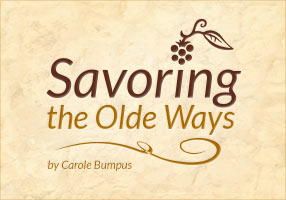TIP: While visiting abroad, if you are searching for a sure-fire recipe to open up a topic of culinary conversation, simply ask your host to tell you about his or her favorite foods as a child.
This was advice I was given about fifteen years ago. Shortly thereafter, I began to put this tip into practice. It was like magic! This should be easy, I thought. Everyone has a favorite food or a favorite story to share. But early on, I realized the necessity of preparing myself for this ‘event’, for an event it often became.
First, I settled into a comfortable chair and accepted the almost-always proffered glass of wine. I would take a sip and then breathe deeply, for I knew with almost giddy delight that once I asked the recipe question I would be in for a most passionate journey.
Immediately, I would notice eyes taking on a faraway look, and even before speaking, a smile would envelop her face. Within seconds, the fondest of memories would rise to the surface—moments of delight of holidays past . . . favorite family foods…cherished traditions…beloved family stories! Before I could even take another sip, my host would leap out of her seat, eyes now bright with excitement as she rushed off to the kitchen. “Here it is!” she’d exclaim as she clamored back to my side. And, she was right. There it was! Still clutched tightly in her hands—all smudged with past effort and spattered with conviction—was proof of a specialty worthy of sharing: her favorite recipe card.
Immediately, her arms would begin flailing, as mixing motions would sweep the air. Within moments, a family treasure would be rattled off and, fortunately, I was prepared. I had put my wine glass down, taken up my note pad, and proceeded to capture her piece of cherished culinary history.
Ah, but every once in a while this process took a different turn. Like peeling the leaves from an artichoke, I found the heart of the matter was sometimes still nestled deeply inside. Maybe it was my abiding interest in food and family, but I was most privileged to hear some of the most intimate stories of generations past recounted.
Last October, having been given permission to bring some of these stories to light, I published my debut novel, A Cup of Redemption, based on some of the stories, recipes and musings of one elderly Frenchwoman, Marcelle Zabel. Now, less than a year later, on August 15, 2015, my second book, Recipes for Redemption: A Companion Cookbook to A Cup of Redemption, will be published. You will find it is filled with the promised recipes from the novel, along with tidbits and banter shared not only by Marcelle, but also her daughter, Sophie and friend, Kate. Yes, they are all back and anxious to have you join them in a rollicking good time as they traverse the French countryside sampling regional foods once again and gathering even more recipes. Share in their fun!
